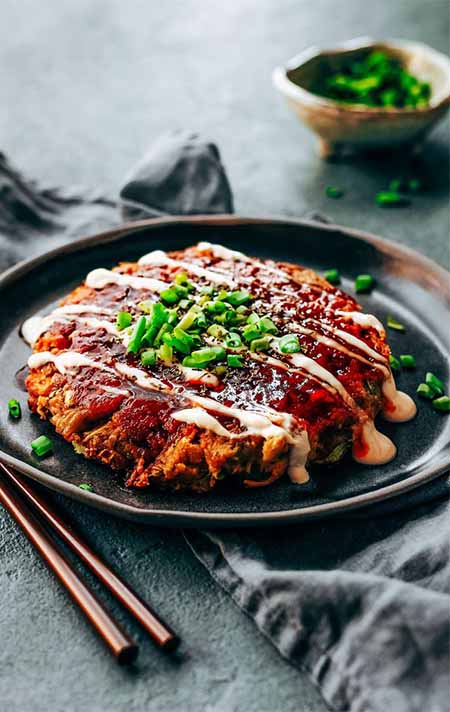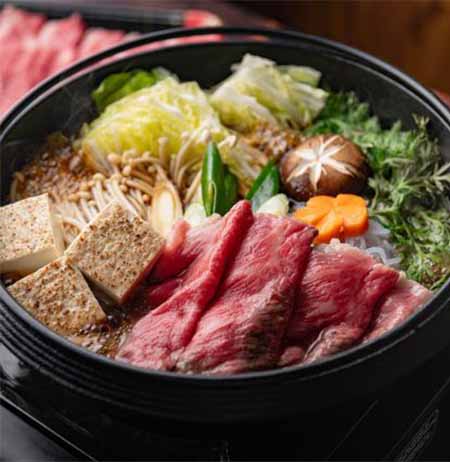Japan’s rich culinary tradition is more than just a delight for the senses—it’s a reflection of centuries-old culture, precision, and artistry. From the bustling streets of Tokyo to the serene countryside of Kyoto, authentic Japanese foods offer a unique glimpse into Japan’s history and values. Whether you’re planning a visit to Japan or looking to explore its cuisine from home, here’s a guide to the best authentic Japanese foods you must try.

1. Sushi and Sashimi: The Icons of Japanese Cuisine
When people think of authentic Japanese foods, sushi and sashimi are often the first dishes that come to mind. These iconic dishes showcase Japan’s dedication to fresh ingredients and simple, refined flavors.
- Sushi is a combination of vinegared rice, fresh fish, and other ingredients like vegetables or seaweed. Popular types of sushi include nigiri (a slice of fish atop a small rice ball), maki (rolled sushi wrapped in seaweed), and temaki (hand-rolled cone-shaped sushi).
- Sashimi, on the other hand, is simply thinly sliced raw fish, served without rice but often accompanied by soy sauce, wasabi, and ginger. The freshness and quality of the fish are paramount, with tuna, salmon, and yellowtail being some of the most sought-after varieties.

2. Ramen: The Soul-Warming Noodle Soup
Although originally from China, ramen has evolved into one of Japan’s most beloved and ubiquitous dishes. This hearty noodle soup has various regional styles, each with its own distinct flavors and ingredients.
- Tonkotsu ramen from Fukuoka is known for its rich, creamy pork bone broth.
- Shoyu ramen, made with a soy sauce-based broth, is a Tokyo favorite, while miso ramen, hailing from Hokkaido, features a broth made from fermented soybean paste.
Ramen is typically garnished with slices of pork, boiled eggs, green onions, and nori (seaweed), making it a comforting and filling meal that’s perfect any time of year.

3. Tempura: Light and Crispy Delights
Another staple of authentic Japanese foods is tempura. This dish consists of seafood, vegetables, or other ingredients coated in a light batter and fried to perfection. Despite being fried, tempura is known for its delicate, non-greasy texture, achieved through precise frying techniques.
Tempura is often served with a dipping sauce made from soy sauce, mirin, and dashi (fish stock), and it’s enjoyed either as a standalone dish or as part of a larger meal. Common tempura ingredients include shrimp, eggplant, sweet potatoes, and mushrooms.

4. Tonkatsu: Japan’s Take on Fried Pork
Tonkatsu is a breaded and deep-fried pork cutlet that has become a popular comfort food in Japan. Typically served with shredded cabbage, steamed rice, and a savory-sweet tonkatsu sauce, this dish offers a satisfying crunch with each bite.
There are two main variations of tonkatsu: hire-katsu (a leaner cut made from pork fillet) and rosu-katsu (a juicier cut made from pork loin). In some regions, tonkatsu is also served as a sandwich or on top of a bowl of rice and curry, known as katsu curry.

5. Okonomiyaki: Japan’s Savory Pancake
Originating from the Kansai region, particularly Osaka and Hiroshima, okonomiyaki is a savory pancake filled with a variety of ingredients. The word “okonomiyaki” translates to “grill as you like,” reflecting the dish’s customizable nature.
The batter typically consists of flour, grated yam, eggs, and shredded cabbage. Ingredients like pork, shrimp, octopus, or even cheese are then mixed in. Once cooked, the pancake is topped with okonomiyaki sauce, mayonnaise, bonito flakes, and aonori (seaweed powder). The result is a flavorful, crispy dish that’s both filling and versatile.

6. Takoyaki: Crispy Octopus Balls
If you ever find yourself at a Japanese street festival, you’ll likely come across takoyaki, a popular street food consisting of round, fried dough balls filled with diced octopus, tempura scraps, green onions, and pickled ginger.
Takoyaki is crispy on the outside and soft on the inside, creating a delightful texture contrast. Once cooked, the balls are typically drizzled with takoyaki sauce and mayonnaise and topped with bonito flakes and seaweed. It’s a fun and delicious snack that embodies the essence of authentic Japanese foods.

7. Sukiyaki: A Sweet and Savory Hot Pot
For those looking to indulge in a communal dining experience, sukiyaki is a traditional Japanese hot pot dish often enjoyed during colder months. Thin slices of beef, tofu, vegetables, and noodles are simmered in a sweet-savory broth made from soy sauce, sugar, and mirin.
What makes sukiyaki unique is that the ingredients are often dipped in raw, beaten eggs before being eaten, adding a rich, velvety texture to each bite. It’s a comforting and flavorful dish that’s perfect for sharing with family and friends.

8. Unagi: Grilled Freshwater Eel
Unagi, or grilled freshwater eel, is a delicacy in Japan, particularly during the summer months when it’s believed to provide stamina and strength. The eel is typically grilled over charcoal and basted with a sweet, savory glaze made from soy sauce, mirin, and sugar.
Unagi is often served atop a bed of rice in a dish called unadon or unaju. Its rich, smoky flavor and tender texture make it a highly sought-after dish among authentic Japanese foods, especially during Japan’s eel-eating season, known as “Doyo no Ushi.”

9. Natto: Fermented Soybeans with a Bold Flavor
While not for everyone, natto is a traditional Japanese food that has a strong, distinct flavor. Made from fermented soybeans, natto is known for its sticky, stringy texture and pungent aroma. It’s often eaten for breakfast, served over rice with soy sauce and mustard.
Though natto can be an acquired taste, it’s highly nutritious and packed with protein, fiber, and probiotics. For those looking to explore the more unusual side of authentic Japanese foods, natto offers a truly unique culinary experience.

10. Matcha: The Quintessential Japanese Green Tea
While not a dish, no exploration of authentic Japanese foods would be complete without mentioning matcha. This finely powdered green tea is deeply ingrained in Japanese culture, particularly in traditional tea ceremonies.
Matcha is made from specially grown and processed green tea leaves that are ground into a fine powder. It has a rich, slightly bitter flavor and is often enjoyed as a hot tea or used as an ingredient in desserts like matcha-flavored ice cream, cakes, and cookies.

The Heart of Authentic Japanese Foods
What sets authentic Japanese foods apart is the emphasis on fresh, high-quality ingredients and the meticulous preparation methods that highlight natural flavors. Whether you’re enjoying a simple bowl of ramen or indulging in an elegant sushi meal, every bite reflects Japan’s deep respect for nature, tradition, and artistry.
As you explore the diverse world of authentic Japanese foods, you’ll discover that Japanese cuisine is not just about eating—it’s about experiencing a rich culinary heritage that has been passed down through generations. Whether you’re a seasoned traveler or new to Japanese food, these dishes offer an unforgettable taste of Japan’s rich culture and flavors.
From sushi and ramen to tempura and unagi, authentic Japanese foods offer a rich and varied culinary experience that is steeped in tradition. These dishes not only tantalize the taste buds but also provide a deep connection to Japan’s cultural heritage. So, whether you’re dining in Japan or exploring Japanese cuisine from afar, make sure to try these essential dishes for an unforgettable taste of Japan.


заработок на аккаунтах маркетплейс аккаунтов соцсетей
площадка для продажи аккаунтов магазин аккаунтов
платформа для покупки аккаунтов перепродажа аккаунтов
аккаунт для рекламы https://ploshadka-prodazha-akkauntov.ru/
продажа аккаунтов продажа аккаунтов
купить аккаунт с прокачкой платформа для покупки аккаунтов
профиль с подписчиками биржа аккаунтов
Online Account Store Account Catalog
Account Exchange Service Secure Account Sales
Secure Account Purchasing Platform Account trading platform
Secure Account Purchasing Platform Accounts marketplace
Account Purchase Account Trading Platform
Database of Accounts for Sale Buy Pre-made Account
Database of Accounts for Sale Account Purchase
Account Buying Service Account Buying Platform
Buy Account Account Selling Platform
Account Sale Account Store
Sell Pre-made Account Social media account marketplace
account marketplace online account store
secure account sales bestaccountsstore.com
buy and sell accounts website for buying accounts
secure account sales find accounts for sale
website for buying accounts account store
account market online account store
account market website for buying accounts
buy pre-made account account buying platform
account trading service account trading service
account purchase account trading
account market accounts for sale
website for selling accounts account store
account acquisition account trading service
account marketplace purchase ready-made accounts
account store guaranteed accounts
account market account catalog
account market account trading
website for buying accounts website for selling accounts
account catalog website for buying accounts
buy account sell accounts
account store account market
ready-made accounts for sale website for buying accounts
account marketplace account store
account catalog secure account purchasing platform
account catalog social media account marketplace
account catalog account market
profitable account sales buy accounts
secure account purchasing platform buy accounts
account market https://accounts-offer.org
profitable account sales https://accounts-marketplace.xyz
account buying platform account marketplace
account buying service https://social-accounts-marketplaces.live/
social media account marketplace https://accounts-marketplace.live
website for selling accounts account marketplace
account sale https://buy-accounts.space/
account trading platform https://buy-accounts-shop.pro/
account purchase https://accounts-marketplace.art/
account trading platform https://social-accounts-marketplace.live/
sell pre-made account https://buy-accounts.live/
account purchase https://accounts-marketplace.online
accounts market https://accounts-marketplace-best.pro
площадка для продажи аккаунтов akkaunty-na-prodazhu.pro
маркетплейс аккаунтов https://kupit-akkaunt.xyz/
площадка для продажи аккаунтов https://rynok-akkauntov.top
маркетплейс аккаунтов https://akkaunt-magazin.online
биржа аккаунтов https://akkaunty-market.live
покупка аккаунтов kupit-akkaunty-market.xyz
биржа аккаунтов https://akkaunty-optom.live
маркетплейс аккаунтов https://online-akkaunty-magazin.xyz
продажа аккаунтов https://akkaunty-dlya-prodazhi.pro
продать аккаунт https://kupit-akkaunt.online
buy aged facebook ads account https://buy-adsaccounts.work
buy facebook advertising accounts https://buy-ad-account.top/
facebook ad account for sale https://buy-ad-accounts.click
facebook ad account buy facebook ad account for sale
facebook ad accounts for sale facebook ad account for sale
buy aged fb account https://buy-ads-account.work
buy facebook accounts cheap https://ad-account-for-sale.top
buy facebook profiles buy accounts facebook
В этой статье представлен занимательный и актуальный контент, который заставит вас задуматься. Мы обсуждаем насущные вопросы и проблемы, а также освещаем истории, которые вдохновляют на действия и изменения. Узнайте, что стоит за событиями нашего времени!
Узнать больше – https://medalkoblog.ru/
buy accounts facebook buy facebook accounts for ads
google ads account buy https://buy-ads-account.top
buy google adwords accounts google ads accounts
buy facebook accounts https://buy-accounts.click
buy aged google ads account https://ads-account-for-sale.top
buy aged google ads account https://ads-account-buy.work
google ads account seller https://buy-ads-invoice-account.top
google ads accounts for sale https://buy-account-ads.work
buy google ads verified account https://buy-ads-agency-account.top
google ads account for sale https://sell-ads-account.click/
buy google adwords account https://buy-verified-ads-account.work
buy facebook business manager account buy-business-manager.org
buy google ad account https://ads-agency-account-buy.click
buy verified bm facebook https://buy-business-manager-acc.org
buy verified business manager facebook https://buy-bm-account.org
facebook bm account https://buy-verified-business-manager-account.org
buy verified facebook buy-verified-business-manager.org
verified bm for sale https://buy-business-manager-verified.org
facebook verified business manager for sale business-manager-for-sale.org
verified bm for sale https://buy-bm.org
facebook business manager buy https://verified-business-manager-for-sale.org
facebook bm for sale buy-business-manager-accounts.org
tiktok agency account for sale https://buy-tiktok-ads-account.org
tiktok ads agency account https://tiktok-ads-account-buy.org
buy tiktok ads account https://tiktok-ads-account-for-sale.org
tiktok agency account for sale https://buy-tiktok-ad-account.org
buy tiktok ad account https://tiktok-agency-account-for-sale.org
buy tiktok ads tiktok ads agency account
tiktok agency account for sale https://buy-tiktok-business-account.org
tiktok ads agency account https://buy-tiktok-ads.org
tiktok agency account for sale https://tiktok-ads-agency-account.org
buy old facebook account for ads account selling platform account selling platform
buy a facebook ad account online account store account buying platform
Your article helped me a lot, is there any more related content? Thanks!
Interesting take on balancing tradition & tech in gaming! The cultural nods at legend link login-like numerology in registration-are a clever touch. Solid strategy for building player engagement, beyond just the games!
Scratch cards are such a fun, quick thrill! It’s cool seeing platforms like boss77 offer that energy digitally, plus a whole casino! Easy access via app download is a huge plus too. 👍
Smart bankroll management is key with any online gaming, and platforms like nn77 seem to emphasize a data-driven approach. Always gamble responsibly! Check out nn77 slot options, but prioritize safe play & set limits. It’s easy to get carried away!